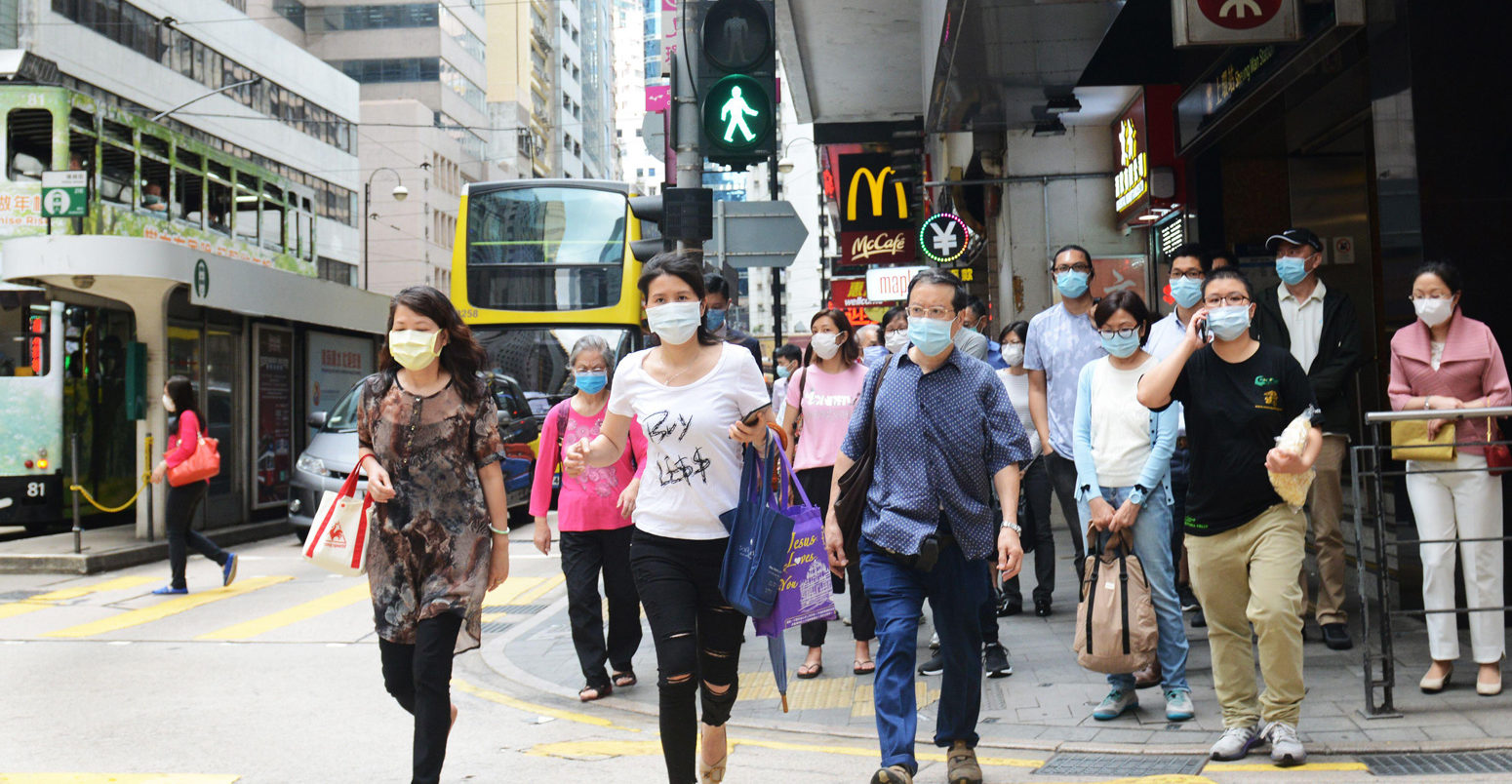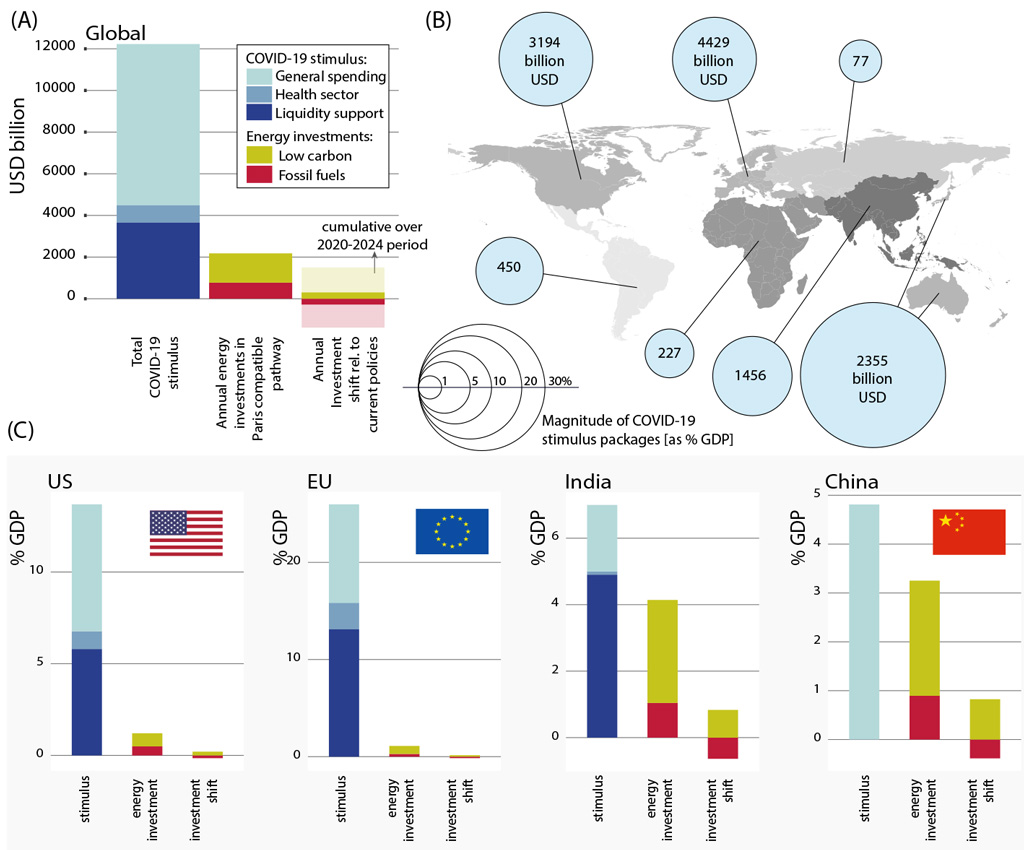
Guest post: How the global coronavirus stimulus could put Paris Agreement on track

Guest authors
10.15.20
Guest authors
15.10.2020 | 7:00pmAround the world, governments have committed more than $12tn to kickstart economies that have been ravaged by the impacts of the Covid-19 pandemic.
This is about 15% of global gross domestic product (GDP) and multiple times more than that put forward in the aftermath of the global financial crisis 10 years ago.
At the same time, climate efforts by governments worldwide are currently insufficient to reach the goals of the Paris Agreement. Today’s policies put the world on a path to around 3C of warming above pre-industrial levels – and the severe climate impacts that come with it.
Recent research warns that the temporary drop in global emissions caused by the pandemic will result in no detectable climate effects in the long run. However, strong green stimulus measures can transform this near-term blip into the long-term emissions reductions that can avoid 0.3C of warming by mid-century – and could help limit it to 1.5C.
In our new analysis, published as a “policy forum” paper in the journal Science, we show that an opportunity for getting on a path to a 1.5C world can be seized if just a fraction of Covid-19 fiscal stimulus is invested annually in a “climate-positive” recovery.
Such a recovery would both stimulate the global economy and accelerate the deployment of low-carbon energy supply and energy efficiency measures.
Stimulus packages
Governments around the world are preparing for what will clearly become a painful economic recovery from the Covid-19 pandemic.
What is equally clear is that the way in which the world emerges from this crisis will have consequences for tackling climate change. But the dual challenges on climate and health also create an opportunity as many governments plan their responses to the economic downturn.
In our analysis, we focus on greening the energy sector, which is currently responsible for about two-thirds of economy-wide greenhouse gas emissions.
Meeting the goals of the Paris Agreement is dependent on steep reductions in the use of fossil fuels and a rapid shift to renewable low-carbon sources, such as solar and wind power – as well as improvements in energy efficiency.
We compare the stimulus packages around the world to annual investments into energy that would be needed to put the world on track to meet the 1.5C temperature goal. Estimates suggest that these investment needs amount to around $1.4tn per year globally between 2020 and 2024.
Our central finding shows that a share of around 10% of the stimulus packages – invested every year – would be sufficient to fund the clean energy transition. If you add up this over the 2020-24 period, it would be equivalent to about half of the total global stimulus committed to date.
This is illustrated in the figure below, which shows how Covid-19 stimulus packages (left-hand bars) compare to the annual investment needed for a Paris-compatible pathway (middle) and the shift required compared to existing policies (right-hand).
The figure summarises these figures for a) the world as a whole, and c) the US, EU, India and China. The map (b) shows the size of individual stimulus packages for each region of the world, where the blue bubbles indicate the stimulus as a percentage of GDP.

Global overview of Covid-19 recovery stimulus and annual investments in the energy system: A) Covid-19 stimulus packages (blue bars) include general spending (measures aimed at non-health sectors of the economy, such as supporting individuals, households and businesses, as well as foregone and deferred revenue), health sector investments, and liquidity support (loans, guarantees and quasi-fiscal operations). Energy investments are representative of average annual energy system investments over the near-term (2020-24) in a low-carbon pathway consistent with achieving the Paris Agreement. Annual investment shifts represent the difference in fossil fuel (red bars) and low-carbon investments (yellow bars) between current policies and a low-carbon pathway consistent with the Paris Agreement. The shaded area illustrates the shift in cumulative investments over the five years of the 2020-24 period. B) Overview of regional magnitude of Covid-19 fiscal stimulus in absolute terms and as a share of GDP. C) As panel A, but for four selected countries and magnitudes relative to GDP. Credit: Joeri Rogelj.
It is worth noting that most of the recovery stimulus is expected to be used over the course of about five years – a key window of opportunity if the world is to stay within 1.5C of warming.
‘Green’ investment
Clearly, the immediate priorities of governments are to support healthcare systems, preserve livelihoods and stabilise employment. Yet the exact detail on how the remainder of the stimulus will be spent remains unclear at present for the large majority of countries.
As shown by Carbon Brief’s tracker of the stimulus measures aimed at reducing emissions, some governments have earmarked portions of the stimulus for green investments.
Support for decarbonising energy systems, for example, can be channelled via direct infrastructural investments, as well as via supporting policies, incentives, rebates and guarantees.
However, it is worth bearing in mind that the criteria for labelling actions as “green” are largely undefined. In our analysis we make a concrete case for how recovering the backbone of every economy can be aligned with ambitious efforts to reduce emissions.
What becomes clear is that, with current policies already putting significant investment into clean energy, it would not be necessary for the whole 10% of stimulus packages to be dedicated to low-carbon investment. Also, not all low-carbon energy investments are expected to be made by governments, but this share is an indication of the difference in orders of magnitude between the stimulus packages and the investments needed to decarbonise energy systems.
For example, meeting global energy needs in a non-Paris compatible way has been estimated to require $1.1tn per year of investment in clean energy over the next five years – plus another $1.1tn per year invested in fossil fuels. Thus, reaching the $1.4tn for a Paris-compatible pathway would only need an additional $300bn per year for low carbon energy. This is equivalent to well below 3% of the total pledged stimulus to date, or 12% cumulatively over the next five years.
These “investment shifts” can be seen by the right-hand columns in the charts in the earlier figure.
This would not mean that energy systems will be fully decarbonised within five years, but that with these annual investments, the global economy would have made an important and positive step towards limiting climate change.
Divestment
As the “non-Paris compatible” example highlights, there are still large sums of money being channelled towards fossil fuels. Therefore, putting the world on a pathway to meeting the Paris goals also requires fossil fuel divestment.
- IEA: ‘Green’ coronavirus recovery would keep global emissions below 2019 peak
- Coronavirus: Tracking how the world’s ‘green recovery’ plans aim to cut emissions
- Webinar: What impact is Covid-19 having on global CO2 emissions?
- Q&A: Could climate change and biodiversity loss raise the risk of pandemics?
- Analysis: Coronavirus set to cause largest ever annual fall in CO2 emissions
- Coronavirus: What could lifestyle changes mean for tackling climate change?
- Analysis: Coronavirus temporarily reduced China’s CO2 emissions by a quarter
In other words, avoiding lock-in into polluting energy sources is just as important as ramping up investments into renewables.
Together with the $300bn annual increase into low-carbon energy, investments into fossil fuels need to be reduced by $280bn per year for a Paris compliant pathway.
The $20bn annual difference between these two estimates – which is essentially the net shift in total energy system investments from current policy projections towards achieving the 1.5C goal of the Paris Agreement – makes up a paltry 0.2% of current global stimulus. That is just 1% in total over the next five years.
A climate-positive recovery would bring about multiple other benefits that governments care about while stimulating the economy, such as job creation, stimulating innovation and technological developments. This has been highlighted by several recent reports, including a survey of over 230 experts worldwide and the latest World Energy Outlook from the International Energy Agency (IEA).
Our analysis also indicates large regional disparities between countries, both in their capacity to address the Covid-19 crisis and in investment needs for clean energy systems – especially when considered as a relative share of economies.
For example, the US and the European Union have pledged most funds for their post-pandemic recovery, but have proportionally the lowest low-carbon energy investments needs for switching onto a Paris-compatible track.
Meanwhile, emerging economies such as India have put forward less funding for pandemic recovery, but require proportionally more investments to decarbonise their energy system while providing their populations with reliable, clean and affordable energy.
These imbalances underscore the importance of international cooperation and sharing efforts to achieve global climate goals.
In very concrete terms, our analysis shows that the more ambitious goal under the Paris Agreement of limiting global warming to 1.5C is still within reach. Decisive leadership, swift action and sound use of scientific advice seems to be a good recipe for coping with both the Covid-19 crisis and our warming climate.
Andrijevic, M. et al. (2020) Covid-19 recovery funds dwarf clean energy investment needs, Science, doi:10.1126/science.abb1970
-
Guest post: How the global coronavirus stimulus could put Paris Agreement on track
-
Guest post: Putting a fraction of coronavirus stimulus into clean energy could put 1.5C within reach

